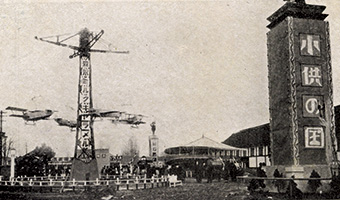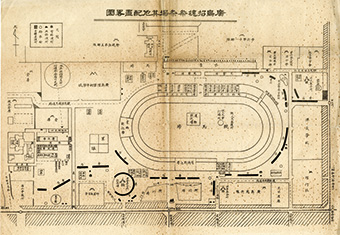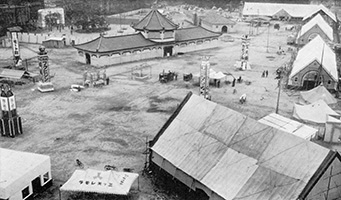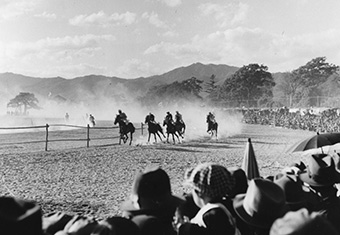The Heart of a Military City - 3
Recreation Area for Citizens
Moto-machi was a military reservation with various military facilities, but it was also a place open to the people of Hiroshima. It became a familiar place where people could enjoy a cool evening, catch dragonflies, and watch the troops training. The Western Drill Ground built in Otekuruwa on the Castle’s south side was usually used as a training ground for troops, but with permission from the military, it could be used for fairs and exhibitions and many events were held there. At the annual Shokonsai Festival held to honor war dead, the people of Hiroshima enjoyed horse races, motocross, and bustling food stalls and show tents.

Showa Industrial Exposition
The Showa Industrial Exposition, which expanded the scale of the products fair even more, ran for 55 days from March 20 until May 13, 1929 and was held mainly at the Western Drill Ground. It was an event to celebrate the merger of Hiroshima City with 7 surrounding towns and villages.
Collection of Hiroshima Municipal Archives

Layout of the Hiroshima Shokonsai Festival
A large horseracing track surrounded by stalls was set up on the Western Drill Ground.
1936 Collection of Hiroshima Municipal Archives

Situation Exposition
The Situation Exposition was an event held mainly at the Western Drill Ground for 17 days from April 29 to May 15, 1932. This event introduced achievements by the Japanese military in the Manchurian Incident which had begun in 1931 and served to encourage support for the war.
Collection of Hiroshima Municipal Archives

Horse and motocross races at Hiroshima Shokonsai Festival
At Hiroshima Shokonsai Festival, horseracing and motorcycle races were held on the Western Drill Ground.
Around 1936 Taken by Noboru Watanabe
Courtesy of Hiroshima Municipal Archives
School trip diary(excerpt)
We finally made it to the Western Drill Ground and saw the cavalry training on their horses. We rested there and then moved on to the Divisional Headquarters. Arriving in front of the gate, there was a sentry in uniform with an imposing sword. When we expressed our desire to see the Imperial Headquarters, a single soldier came out, gave us consent, and led us inside. As we progressed further on, 2 or 3 sentries like the one at the gate stood at attention. Here are the renowned ruins of the Imperial Headquarters. An officer came out and explained its history and some things to take heed of as we visited. We left our hats and lunches there and went to view the main room. First off, I was surprised by the solemnity, silence, and modesty. I thought about the late emperor, a member of an awe-inspiring unbroken imperial lineage, living in this cramped, crude room for more than 6 months and became overwhelmed by emotions. I was in awe. Afterwards, we went downstairs and viewed weaponry and some of the spoils of wars. There was nothing surprising among all of the great variety of things. After everyone had finished their visit, we left the Imperial Headquarters and hurried to see the 71st Infantry Regiment barracks, but mobilization orders were given to them that morning, so we weren’t able to visit them.

Composition notebook
Seijiro Nakagawa, a student from Onoshita Normal Higher Elementary School (now, Hatsukaichi Municipal Ononishi Elementary School) in Ono Village, Saeki County (now, Ono, Hatsukaichi City), used this notebook in his composition class.
1914-1915 school year
Collection of Hiroshima City Museum of History and Traditional Crafts
